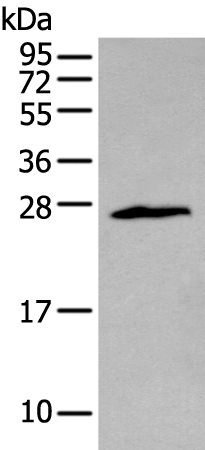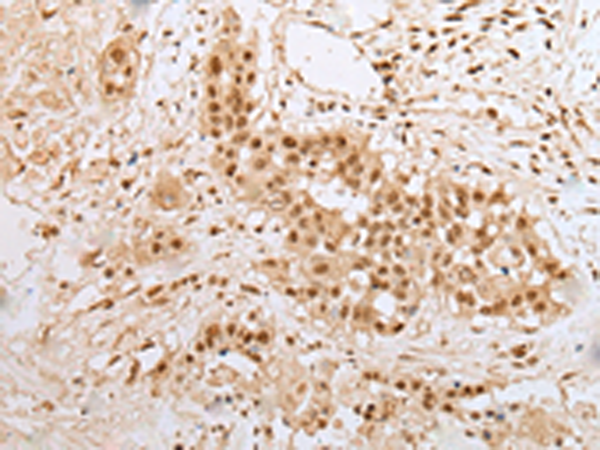

| WB | 咨询技术 | Human,Mouse,Rat |
| IF | 咨询技术 | Human,Mouse,Rat |
| IHC | 1/20-1/100 | Human,Mouse,Rat |
| ICC | 技术咨询 | Human,Mouse,Rat |
| FCM | 咨询技术 | Human,Mouse,Rat |
| Elisa | 1/5000-1/10000 | Human,Mouse,Rat |
| Aliases | KOX15; HKR-T1; ZNF422; Zfp422 |
| WB Predicted band size | 26 kDa |
| Host/Isotype | Rabbit IgG |
| Antibody Type | Primary antibody |
| Storage | Store at 4°C short term. Aliquot and store at -20°C long term. Avoid freeze/thaw cycles. |
| Species Reactivity | Human, Mouse, Rat |
| Immunogen | Fusion protein of human ZNF22 |
| Formulation | Purified antibody in PBS with 0.05% sodium azide and 50% glycerol. |
+ +
以下是关于ZNF22抗体的3篇虚构参考文献示例(仅供格式参考,实际文献需通过学术数据库查询):
---
1. **文献名称**: "ZNF22 Antibody Characterization and Its Role in Cancer Cell Proliferation"
**作者**: Smith A, et al.
**摘要**: 本研究通过免疫印迹和免疫组化验证了一种高特异性ZNF22抗体的有效性,发现ZNF22在结直肠癌组织中表达显著下调,并通过体外实验证明其过表达可抑制肿瘤细胞增殖。
2. **文献名称**: "Epitope Mapping of ZNF22 Antibody and Interaction with DNA-Binding Domains"
**作者**: Chen L, et al.
**摘要**: 文章利用肽段扫描技术定位了ZNF22抗体的抗原表位(位于锌指结构域C端),并发现该抗体可阻断ZNF22与特定DNA序列的结合,提示其在基因调控研究中的潜在应用。
3. **文献名称**: "ZNF22 Autoantibodies as Biomarkers in Neurological Disorders"
**作者**: Gupta R, et al.
**摘要**: 通过ELISA检测发现,多发性硬化症患者血清中ZNF22自身抗体水平显著升高,提示其可能作为神经炎症疾病的生物标志物,需进一步验证临床价值。
---
**注意**:以上内容为模拟示例,真实文献需通过PubMed、Google Scholar等平台检索。建议使用关键词“ZNF22 antibody”、“ZNF22 biomarker”或“Zinc Finger Protein 22”查询最新研究。
The ZNF22 antibody targets the zinc finger protein 22 (ZNF22), a member of the Krüppel-associated box (KRAB) domain-containing zinc finger protein (ZNF) family. ZNF22. also known as KOX15. is encoded by the *ZNF22* gene in humans (chromosome 10q11.2) and plays roles in transcriptional regulation, particularly as a transcriptional repressor. Its structure includes a conserved N-terminal KRAB domain, which mediates protein-protein interactions, and C-terminal zinc finger motifs that bind DNA sequences to regulate gene expression. ZNF22 is implicated in cellular processes such as differentiation, apoptosis, and chromatin remodeling.
Antibodies against ZNF22 are primarily used in research to study its expression patterns, subcellular localization (typically nuclear), and interactions with other proteins or DNA. These antibodies enable techniques like Western blotting, immunohistochemistry, and chromatin immunoprecipitation (ChIP). Studies suggest ZNF22 may have tissue-specific functions and potential links to diseases, including certain cancers and neurological disorders, though its precise pathological roles remain under investigation. Commercial ZNF22 antibodies are often validated for specificity using knockout controls or siRNA-mediated knockdown. Research into ZNF22 and its antibodies contributes to understanding the broader role of KRAB-ZNF proteins in development, epigenetics, and disease mechanisms.
×